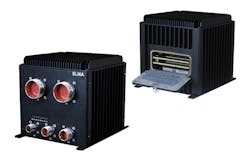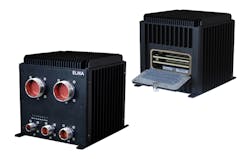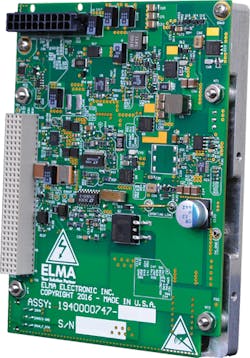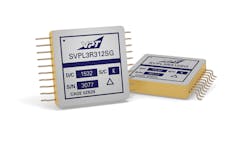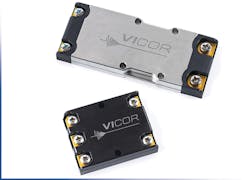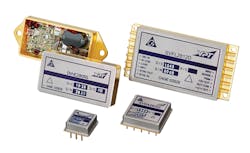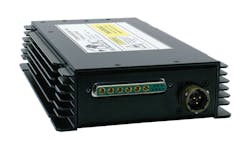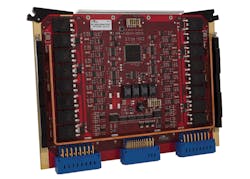Military power electronics seeks to increase voltage and efficiency
Power control for aerospace and defense applications aims at sometimes-conflicting demands for custom designs, open-systems standards, and the ever-present quest for small size, weight, power consumption, and cost (SWaP-C).
Modern aerospace and defense electronics applications are calling for power control and conditioning components that offer increasing amounts of power density, efficiency, and voltages to meet often-stringent requirements of small size, weight, power consumption, and cost (SWaP-C).
At the same time, however, the power industry is confronting requirements from other directions — namely growing needs for high-power systems like laser weapons, all-electric aircraft, and many other applications that are demanding high power and low SWaP-C.
“Things are getting smaller and more powerful,” says Jeffrey Ham, principal applications engineer at Vicor Corp. in Andover, Mass. “The smaller we can make something and the more powerful we can make it, enables our customers to meet their needs.”
Designing electronics that are smaller and more powerful than ever before is an imperative that runs across the industry’s waterfront, and power electronics is no different. “SWaP-C challenges are still paramount,” says Robert Russell, vice president of product marketing at Vicor. “Our idea is to improve on the SWaP-C metric while letting our customers do what they are good at, so they can do what they do.”
Elma Electronic is in the rugged embedded computing business, yet company engineers have designed their own VPX and small-form-factor embedded power modules to meet customer needs.
The ability to take-on SWaP-C is one of the strongest pitches that Vicor officials make to their customers. “Our products draw a lot of interest for size and weight, where customers need a lot of power in a small package,” says Tom Curatola, field applications engineer at Vicor. “They look at our expertise to pack a lot of power into a small package.”
One design approach Vicor takes to meet SWaP-C requirements is replacing traditional brick packaging with the company’s DCM packaging approach, which helps them design devices that are two to three times smaller than the company’s previous-generation power bricks. Vicor DCM products are not really bricks, but are power components that are in a much smaller package. For DC-DC converter applications, to meet SWaP-C requirements, that DCM family is gaining momentum very rapidly,” says Vicor’s Russell.
Increasing voltage challenges
One of the primary challenges for power systems designers today is squeezing every last bit of power out of ever-more-tightly packaged power components. “Everybody always asks for higher power density and efficiency,” says Leonard Leslie, vice president of engineering at VPT Inc. in Blacksburg, Va.
“We get requests for increased power in the same package, and less power dissipation from our products,” Leslie says. “As systems get more complex, and as they try to do more in the same space and weight, they are pushing for a more dense solution.” VPT engineers are approaching this challenge with updated power topologies like synchronous rectification. “Some of the things we’ve worked on are wider input voltage ranges to meet mil-specs without additional modules in front of the converters,” he says.
Elma Electronic engineers have designed their own CompactPCI small-form-factor embedded power modules to support the company’s line of small rugged embedded computers.
New kinds of packaging can be key to meeting today’s power challenges. “To move to higher voltages, we need packages that meet clearances for safety,” says Vicor’s Ham. “Having a higher-voltage device lets you use less copper to drive current. We need to reduce the amount of current flowing around at a given voltage level. The driver is the customer’s desire to reduce the size of his payload without adding more copper for moving current at lower voltages.” The U.S. Army-Marine Corps Joint Light Tactical Vehicle (JLTV), for example, is moving up to 600-volt systems for a variety of power needs — sometimes even higher — Ham points out.
Not only can higher voltages help increase overall system power, but they also play a role in keeping SWaP to a minimum. A relevant application is tethered unmanned aerial vehicles (UAVs), which receive their operating power and instructions through a thin cable to the ground. “In the tethered drone market, anything that can be done to reduce the size of the tether is important, so the higher the voltage, the smaller the cable size that is necessary.”
Not only do systems designers need higher-voltage systems than they have in the past, but they also need cleaner and more precise power control.
“Some of the things that before might have been acceptable include living with harmonics,” says John Santini, chief technologist at Data Device Corp. (DDC) in Bohemia, N.Y. “Now they are saying we can’t afford those harmonics anymore, and need a true power factor corrector. The Navy, for example, for years has used multi-pole transformer rectifier setups, or some kind of passive power factor correction. Now our customers are saying we need active power factor correction, so then you are driven to an active solution.”
The VPT SVPL series of space-qualified point-of-load DC-DC converters is designed for the harsh radiation environment of space applications.
Shift to high power
It’s a given that military electronics designers want more power at their disposal, and it’s up to the power industry to give it to them. “I’m seeing a lot more high-power and high-voltage opportunities — 270 volts and up,” says Steven Goldman, product line manager for solid-state power controller products at DDC. “That’s a big shift for us, and we are going to higher voltages and higher power.”
Much of the shift to higher-power systems comes from the hybrid and electric vehicle industry. Military systems designers want to take advantage of these maturing power technologies as they move to ever-more powerful systems.
“We are seeing a lot of higher-power requirements driven by motive systems,” explains DDC’s Santini. The commercial electric power market is centered on 370 volts for the automotive market. There are small hybrid vehicles and some high-power drives that are centered on 400 volts.”
This has military systems designers thinking about how to implement tomorrow’s systems like all-electric drones. “That’s when you start seeing 370-volt buses instead of just 270-volt buses in military applications,” Santini says.
Vicor Corp. is looking beyond the traditional power brick module to offer new designs that are two to three times smaller than previous-generation power products.
Additional high-power military applications involve the emerging generation of laser weapons, as well as systems that are moving away from hydraulic actuation to electric power. “In high-power systems, we are seeing customers looking even for 1,000-volt systems,” says DDC’s Goldman. “This is pushing us to the higher-power requirements; they need all the power they can get. Those laser weapons use a super-capacitor to power and fire the weapon.”
In response to high-power demands, DDC last year introduced the RP-28001000N0 MIL-STD-704F-compliant 12-channel, 270-volt DC, 150-amp solid-state power controller, initially for vetronics in military land vehicles.
The RP-28001000N0 offers programmability, system health diagnostic and prognostic data, and high power density in a compact and rugged form factor. It employs DDC’s technology, with more than a million nodes installed on military and aerospace systems since 1988, including on the Joint Light Tactical Vehicle (JLTV). “We have had a lot of requests for that board since we introduced it,” says DDC’s Goldman. “Ever since we went to 150- and 270-volt devices it has inserted us in a lot of different applications, like mission pods, electro-optical sensors, radars, and things going into manned and unmanned aircraft pods.”
The trend to higher power has no end in sight. “The biggest thing is we will have applications in 270 volts DC and 370- and 400-volt buses because it is widely used in commercial automotive,” says DDC’s Santini. “There’s also a lot of discussion about solar power. For forward-based soldiers, the environment is not really known, and solar power is a big benefit because you don’t have to truck in fuel as much. Some of the bigger solar systems are 300- and 400-volt systems.”
VPT Inc. in Blacksburg, Va., is offering several different radiation-hardened power electronics devices for use aboard manned spacecraft and satellites, as well as for high-altitude aircraft.
Of course, systems designers cannot design for high power without considering electronics cooling and thermal management. “All our systems are conduction cooled,” says Michael Agic, business unit manager for power control products at DDC.
“People who really use a lot of power think about cooling — and they think about liquid cooling,” Agic continues. “Then there are customers who are not really power users — they have pods that do specific functions — and for them thermal management is an afterthought. For those we have to guide the customer along.”
Standards, COTS, and custom
In this era of open-systems industry standards, most people might thing that power control and conditioning components would be jumping quickly on the standards bandwagon, but actually the opposite is true. “We are doing a lot of customization for 5- and 3.3-volt systems,” says Dan Arnhols, western sales manager at Milpower Source in Belmont, N.H. Milpower Source specializes in extremely rugged power components and subsystems in aerospace and defense applications. “If we design for 12-volt systems, the customization happens with 5- and 3.3-volt systems,” Arnhols says. “Everyone wants something unique.”
DDC’s 280-Watt power converter supplies 28 volts of power for in-flight entertainment and USB charging ports for portable electronic devices on passenger aircraft.
Even at the electronic enclosure and chassis level, requests for custom power designs are routine. “One trend involves some kind of custom power supply design,” says Ram Rajan, senior vice president of engineering at Elma Electronic in Fremont, Calif. It’s always a challenge for a power supply company to engage in programs because of the initial low volumes.”
The increasing use of rackmount embedded computing systems that conform to industry standards like OpenVPX presents its own set of challenges. “It’s very difficult to find an off-the-shelf solution that conforms to our rackmount requirements,” Elma’s Rajan says. “The trend is custom power supplies because they need shelf-management solutions. It’s very program-driven, and is difficult for commodity power supply companies to meet those requirements.”
Milpower Source engineers are meeting demands for custom power with libraries of power designs that can go together quickly for custom power solutions. “Milpower has 3,000 individual power designs,” Arnhols says. “We have a library of already-proven circuits we can mix and match to tailor for a customer’s application; we don’t have to go back and re-invent the wheel. That’s a big plus for our customers, who are very nervous that a custom design will have a lot of issues, but we remove that in a custom design.”
That’s not to say that open-systems standards are not taking part in power electronics; quite the contrary.
VPX and VITA 62
The ANSI VITA 62 specifications for VPX modular power supplies define the power-generation requirements for power modules that support a VITA 62 slot on the VPX backplane. It uses the standard VPX 3U/6U form factor, and offers functionality that includes N+1 failover, VBAT, and 50-millisecond holdup. It also defines connectors that mate with a VITA 62-compatible backplane.
VITA 62.1, meanwhile, provides requirements for building a high-voltage 3-phase 3U-class front-end power supply module that can power a VPX chassis. The module will fit within the standard envelope defined for VPX modules in the VITA 48.0 standards.
DDC’s rugged 12-channel solid-state power controller board provides control, protection, and continuous monitoring to 150 amps to 12 independent electrical system loads.
“We are focusing on VITA 62 to be able to have a common architecture and a common set of features that people can mix and match to create a system,” says Milpower’s Arnhols. “Innovation is putting power on a 3U or 6U form factor, and DOD [the U.S. Department of Defense] is mandating VITA 62 going forward. Our innovation is dealing with the challenges of putting power in a very small space, and dealing with the thermal issues that people need to deal with.
“People want as much power as they can get in a single board, and get the output that their customer requires,” Arnhols continues. “They want flexibility in the VITA 62 power card, and that is what we bring to the table. We can say, here is our standard power card, yet deliver custom changes, usually at no extra charge.”
Vicor also is joining the VPX parade with new VITA 62 products. “In VPX we are seeing a lot of adoption,” says Jim Kotopka, the company’s director of business development. “That’s why we are investing heavily in that area, and are developing a family of products to support it.”
Elma is directly involved in the embedded computing business, yet in the recent past company engineers designed their own VITA 62-compliant power supplies. Now that the VITA 62 market is taking shape, however, “we want to step away from that,” Rajan says. “VPX solutions filled a niche, but now we are moving to small-form-factor applications with power supplies that fill a small slot.”
